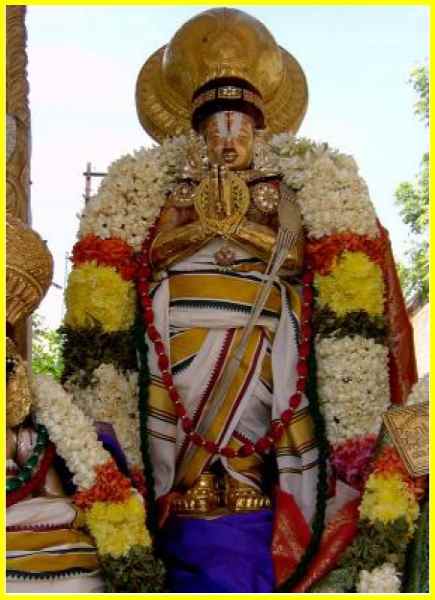
விளக்கவுரை
(இது வரை கூறப்பட்ட பாசுரங்கள் அனைத்தும் உபோத்காதம் எனப்படும் முன்னுரை ஆகும். இனி வரும் பாசுரம், மூலம் தனது துதியைத் தொடங்குகிறார்) உலகவிஷயங்களை அடையும் பொருட்டு, “ஆட்டை அறுத்துக் கொடு, உன் தலையை அறுத்துக் கொடு” என்னும் க்ஷூத்ர தேவதைகளையும், மற்ற தேவதைகளையும் ஆராதித்து, அதனால் ஏற்படும் அஜ்ஞானம் என்ற இருளில் முழ்கி பலரும் வருந்துகின்றனர். இத்தகைய அஜ்ஞானம் என்ற இருள் நீங்கும்படியாக, நமக்கு ஏற்ற உபகாரம் செய்தவர் பொய்கையாழ்வார் ஆவார். வேதாந்தத்தின் முழுப் பொருளும் விளங்கும் விதமாகவும், “நடை விளங்கு தமிழ்” என்று போற்றப்படும் அழகான தமிழ் மொழியையும் இணைத்து அவர் செய்த உபகாரம் என்ன? தன்னிடம் சேர்ந்து விடும்படி அவரை அணுகி, ஸர்வேச்வரன் நெருக்கியபோது (முதல் ஆழ்வார்கள் மூவரும் திருக்கோவிலூரில், ஒருவரை ஒருவர் அறியாமல் நிற்க, அவர்களை விளக்கும் விதமாக ஸர்வேச்வரன் அவர்களுக்கு இடையில் புகுந்து நெருக்கி நின்றான்), “வையம் தகளியா” என்ற பாசுரம் மூலம் உயர்ந்த திருவிளக்கை ஏற்றினார். இத்தகைய ஞானம் என்ற திருவிளக்கைத் தனது நெஞ்சத்தில் எப்போதும் ஏற்றி வைத்து, நிலைக்கும் ஆசார்யரான எம்பெருமானார் நமக்கு ஸ்வாமியாக உள்ளார்.
Unto seven verses, it is considered as an introduction to Iraamaanusa nooRRanthAthi. They were also to extol the greatness of Ramanuja. The following verses of the work are Acharya’s involvement and enjoyment of each AzhwAr and their work. He starts off with the anusanthAnam on mudhalaazhwaars, namely Poigai, bhU and PeyAzhwArs.
Meaning
Without realizing the eternal belongingness/ association of the soul (athmA) to Emperumaan Sriya:Pathi Sriman Narayana, human beings worry unnecessarily about the external material objects lying in the outside world. To remove such a worry from humans, the most merciful PoigaiAzhwAr combined the pure Tamil and the deep vedaanthic meanings to sing the great Tamil pAsurams describing the basic Vedic truth housed in simple Tamil words, “Vaiyam thagaLiyaa” (such that we all can understand) so nicely.
Sri Ramanujacharya, who endears of such great work of PoigaiAzhwAr (which is like a lustrous lamp) and thinks of those verses always in his mind, is always my Master- my Lord.
The first ThiruvanthAthi of Poigai AzhwAr [out of first three hundred verses of mudhal AzhwArs] is tamil verses interwoven with Vedanthic truth. This is the most wonderful weaving. With this, the jnAna viLakku [lamp of knowledge] gets rid of attachment and dirt of craving for other material objects and desires. This is the ThiruvuLLam of Emperumaanaar about mudhal ThiruvanthAthi is Amudhanaar’s view. All three hundreds do have this characteristic. Based on individual verse lines, the meaning needs to be interpreted.
A Glance at their marvelous compositions:
1. poigaiAzhwAr composed the first 100 pAsurams “mudhal thiruvandhAdhi” (andhAdhi means the first word of one verse will be last word of the previous verse) starting with the first one:
vaiyam thagaliyA, vArkadlE neyyAga/ veyyakkadirOn viLakkAga/ sudarAzhiyAn adikkE soottinEn son mAlai/Idar neenghugavE enRu/
Meaning:
Lord nArAyaNa, who holds the Divine chakrAyudha, is the cause of this wonderful universe and the seas. I am singing these mAlai (Garland) of verses (pAsurams) and dedicating to Him, whose vision I had is the light of the lamp of the earth, and oil being the seas, the sun being the source of the light;
2. BhoodaththAzhwAr composed the second 100 pAsurams “irandAm thiruvandhAdhi” starting with the first one:
anbE thagaliyA, ArvamE neyyAga/ inburugu sindhai idu thiriyA/ naNpurugi GnAna chudar viLakku EtrinEn/Gnana thamizh purindha nAn/
Meaning:
Here, it is the love as the lamp and involvement as the oil and azhwAr says” I dedicate myself to the service of the lord, by singing this song that blesses wisdom (GnAna), with love as the lamp, endearing involvement as the oil (Ghee), and knowledge as the wick of the torch”.
3.PEyAzhwAr composed the third 100s called “moonRAm thiruvandhAdhi”, with the first one as follows:
thirukkaNdEn, ponmEni kaNdEn- thigazhum/arukkan Ani
niRamum kaNdEn-seruk kiLaRum/ ponAzhi kaNdEn puri
sangham kai kaNdEn/ en Azhi vaNNan pAl inRu/
AzhwAr just says:” I have seen and found the Glorious, GOLDEN hued form of the SrI Visishtan. I have seen the Glory of Sri and nArAyaNa and His beauty and His blue hued ocean colour, His brightness and brilliance like the Sun and His sanghu (Divine Conch) on one hand and chakrA (Discuss) on the other.
Source:









